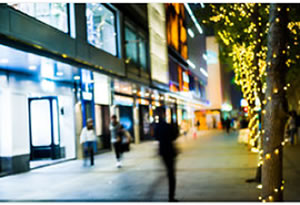
Run, Hide and Fortify®: Individual Preparation
John Farrar, our guest blogger this month, brings us part two of the Run, Hide and Fortify® series – ‘Individual Preparation and Situational Awareness’ – become aware of your surroundings and what to do when crisis situations occur.
Everyone should strive for a general awareness of his or her immediate environment. It doesn’t take years of meditation or graduating from some High-Speed Low Drag training course. The idea is to just be present in the here and now. Try not to be so engrossed in the minutia of day-to-day life and just be aware of what is around you. Take note of things that appear out of the ordinary. We are all the subject matter experts of our own environment. I’m willing to bet a paycheck that you can take the best trained Tier 1 Counter Terrorist or Intelligence Operative and place them in an unfamiliar environment without any prior training about the location and they will perform only marginally better in assessing the local risks than a resident that has been living there for any length of time. They will just know the normal baselines for activities in that given locale.
If only I had been paying better attention while walking the dog I may have avoided stepping in a small hole and breaking my ankle. I was too busy walking, messing with my ear buds, scanning for traffic, and fiddling with my cell phone as I was trying to start listening to a podcast. Bad stuff will still happen but we can minimize the chances of them occurring through focusing better awareness of our surroundings. It might come in handy as you go through your daily lives. As an old Medical Examiner once said, “The morgue is full of people who had the right of way.”
The fancy term for this awareness is Situational Awareness and is one of the best things a person can cultivate and maintain throughout their life. It not only can help prevent breaking an ankle or getting hit by a car but also is one of the most effective ways to deter both potential crime and even terrorist incidents.
A nexus exists between both a lot of crime and the vast majority of terrorist events. It’s what the “experts” call Pre-Operational Surveillance. Cops generally call it casing. Both terrorists and criminals are constantly scanning for targets. In general terms, they are relatively rational thinking people with a desire to successfully accomplish an objective whether it’s to attack an Embassy or break into that nice car with the Coach purse sitting on the passenger seat floorboard. The objectives and reasoning behind the acts might be different but the steps taken to accomplish the objective are somewhat similar.
They conduct surveillance of potential targets. The level and persistence of this surveillance is generally proportional to the level of the planned activity. While Car Prowlers might ride a bike down a street glancing into vehicle windows, a bank robber will spend more time looking at a Bank from different locations to get a better estimate for the things they look at while planning a robbery. Some Active Shooters are known to have done extensive planning, research and even Pre-Operational Surveillance prior to their acts. The key is to detect these activities at this stage and try to deter them.
Examples include any activities that lie outside the range of normal or baseline behaviors or expectations. For example, I once I had a call on a suspicious person videotaping at a local Mall. I didn’t really think much of it until I contacted the complainant who told me that the subject was alone and had been videotaping the Mall’s loading docks that were in a tunnel underneath the stores. That definitely raised the level of suspicion. While videotaping a water fountain or some other tourist like structure is normal for vacationers I don’t recall seeing anyone’s vacation photos of where the delivery trucks unload.
Another concept that assists with decision-making is the “totality of circumstances.” It was one of the best things I was taught at my Law Enforcement Academy. To put it in simple terms, someone walking down the street in a heavy coat makes sense during the winter. But, the same person walking down the street in a heavy coat during a hot summer’s day doesn’t. While that may not be in itself justification for being too alarmed the fact that you can see a sling strap going diagonally across his back and the seeing the subject walk into a school would start to heighten the suspicion.
If you notice suspicious behavior, report it. Make sure to articulate the reasons why you believe the behavior is suspicious. If you are an employee of a business that you suspect is under surveillance make sure to report it to a supervisor. Hopefully, your employer has an established reporting procedure but if one doesn’t exist let your boss know. I have more recommendations for businesses in Part Three of this series – A Recommended Approach for Business.

If you suspect someone is engaging in these types of activities don’t confront them yourself. Report it. You have no idea who this person is, their background or their intentions. Just report what you observed and why you thought the behavior was suspicious.
When you go to into unfamiliar buildings try and locate alternative points of entry and exit. The bad guys are increasingly becoming more sophisticated in these incidents and increasingly are taking steps to control their potential victims’ points of escape or to slow down responding Police Officers. In the Virginia Tech shooting the suspect used chains with padlocks to secure various doors prior to shooting. In another instance the suspect used his vehicle to block a back door at the business he was recently fired from. The great thing about safety is that most of the concepts cross over a wide range of potential issues. Being aware of multiple entry and exit points comes in handy whether you are attempting to avoid your Supervisor, an armed gunman or if a fire breaks out in a Lobby area and you can’t go out the front door.
There are numerous books out there that assist with the creation of a more aware self. The book, Left of Bang, describes the program that the United States Marine Corps is doing to teach an improved “Situational Awareness” to their personnel. The meaning of the book is a description of how they are attempting to get Marines to be more proactive and to act prior to the “bang” or incident instead of being in a continual reactive mode. I highly recommend the book as well as the classic, The Gift of Fear by Gavin de Becker.
This concludes Part two of the Run, Hide and Fortify® series. Hopefully, it gave you an idea of how everyone should strive for a general awareness of his or her immediate environment and what to do if a situation should arise.
Stay tuned for Part Three, ‘A Recommended Approach for Business continuity planning to help deal with potential threats to a company be it manmade or a natural disaster.
John Farrar graduated from the University of Washington and has been a Police Officer for over 20 years in a large Metropolitan City and served in a variety of positions including Crime Analyst for 5 years.
John has training in a wide variety of fields including Interview/Interrogation, Surveillance, Eastern European Organized Crime, Crime Analysis, Terrorism Analysis, Terrorism Awareness and advanced training in Criminal Investigative Analysis (Profiling). His technical training consists of hardware/software, preservation of digital evidence, management of digital investigations and computer forensics as well as Cyber Terrorism on network security.
He is also a graduate of the DEA Intelligence Analysis Course taught at Quantico, Virginia.
For further information on Security, Terrorism and other items of interest, check out John’s blog at www.intelligencereview.net.
